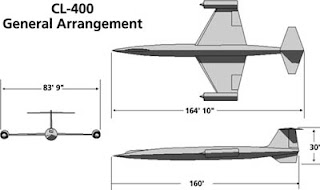 |
| CL-400 "Suntan" (Picture I) |
Kimmo Huosionmaa
Lockheed CL-400 "Suntan" test plane from 1950's is not so well-known as the U-2 or some other reconnaissance planes, what were made under the legendary C.H "Kelly" Johnson at the Lockheed "Skunk Works". This plane was the first attempt to create the hydrogen-powered aircraft, and the experience of that plane was after used to create "Skylon" space planes and other hydrogen-powered aircraft.
"Suntan" is looking unique, because the motors are at the end of the wings, and that solution gave extra protection for the test pilot because if the motors were exploded, the debris would not come thru the fuselage. Other reasons for that solution was, that it gave more space in the fuselage, and the heat of those motors would not warm the fuel tanks. Sometimes have been mentioned, that the position of the motors guaranteed cleaner air intake.
There actually were many reasons for the positioning of motors so far away from the pilot as possible because nobody knew anything about the use of hydrogen in the jet motors, and that made "Suntan" extremely dangerous for its pilot. The problem with aircraft is, that should have electric power because the avionics and communication equipment needs electricity, and that makes difficult to use ramjet-motors because those motors have not the turbine, what gives electricity.
 |
| CL-400 "Suntan" 3-view drawing (Picture II) |
The "Suntan" was the unique prototype, what remained in history a half of the century until some engineers started to work with new kind of space plane "Skylon". This new space plane used the similar solutions as "Suntan", and it has the new type of solutions for creating electric power. The precise information of "Skylon" has been kept out of publicity, and the system, what is used in that plane, could be the combination of RAT (Rapid Air Turbine), where the draught would rotate turbine and generator for creating the electric power, and at the outside of atmosphere this system uses fuel-cells.
Used motor-type might be flap-ramjet, where would be injected the oxygen when the aircraft is too high, that motors would not get enough air. This motor is known as the rocket-ramjet, and it's more conventional than scramjet. In rocket ramjet, the normal dam-tube engine would send the aircraft in high altitude, and then the flap would be closed, and oxygenized will be injected into the chamber.
For the acceleration for the speed of Mach 1 would happen by using normal jet engines. At the speed of 800 km/h would be enough for starting ramjets, but the Mach 1 seems better. When the ramjets have been started the closing system of air intakes of the plane would start to regulate the speed of air, and the turbine would create the electric power for the aircraft. And when this aircraft would rise high altitude, would the oxygen injection start, and the "Skylon" would start the "ballistic jump".
 |
| Skylon (Picture III) |
The reason, why this plane would not use internal oxygen is that the solution, where the part of the flight time would be used external oxygen will spend the weight of this plane, and also give more room for cargo. The cargo of this system would be satellites, what would be launched to the LEO (Low Earth Orbiter). This might not seem very impressive, but there is a possibility that to this satellite will be docking the rocket stage, what would launch with the different shuttle or rocket. This would give the opportunity to use large rocket stages like "Centaur"-stages.
Those stages would allow the satellite to make maneuvers in the trajectory, and that would improve the survivability of the civil and military satellites. Those satellites can make the evasion movements in the case, that something would try to impact with the satellite. And also the sudden changes in horizontal and vertical trajectories is more easy with the large rocket stages. But also the launch of the space probes would be possible, and that would mean, that the probe would be released to LEO, and then necessary rocket stages will be connected to it.
Sources:
https://www.globalsecurity.org/intell/systems/suntan-8.htm
https://aviation.stackexchange.com/questions/22765/why-did-the-cl-400-suntan-have-engines-on-the-ends-of-its-wings
https://history.nasa.gov/SP-4404/ch8-3.htm
https://en.wikipedia.org/wiki/Skylon_(spacecraft)
Picture I
https://www.globalsecurity.org/intell/systems/images/suntan-image04.jpg
Picture II
http://xplanes.free.fr/suntan/images/cl-400.jpeg
Picture III
http://www.bisbos.com/images_rel/skylon_2_800.jpg




No comments:
Post a Comment
Note: Only a member of this blog may post a comment.